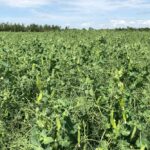MarketsFarm — The hot and dry summer that has enveloped all of Western Canada is already bringing down projected yields for feed grains, creating an inverse effect on prices. “We’re losing the crop here right now with the heat and lack of moisture across the Prairies and the northern Plains of the United States,” said

Feed weekly outlook: Heat reducing potential yields, raising prices

Pulse weekly outlook: Container crisis affecting markets, shipments
MarketsFarm — As hot and dry weather, especially in Western Canada, have wrought havoc on Canadian pulse crops and raised prices, it’s also becoming more difficult to export pulses overseas. Shipping containers, in which 30 per cent of Canada’s peas and more than 50 per cent of Canada’s lentils are transported, are currently in a

CBOT weekly outlook: Inflation another major concern for traders
MarketsFarm — While weather has become a primary factor in rising commodity prices over the past week, traders at the Chicago Board of Trade are also paying close attention on inflation. Earlier Wednesday morning, the U.S. Bureau of Labor Statistics announced that the producer price index (PPI) increased by one per cent, more than expected,

USDA pegs wheat ending stocks to be lowest since 2013-14
MarketsFarm — As the U.S. northern Plains continue to deal with severe drought conditions, the U.S. Department of Agriculture (USDA) has significantly lowered its 2021-22 ending stocks estimates for wheat — especially durum and spring wheat. According to USDA’s monthly world agriculture supply and demand estimates (WASDE) released Monday, 2021-22 ending stocks for wheat are

Feed weekly outlook: Alberta feed prices rising
MarketsFarm — Higher-than-normal temperatures and continued demand for feed have caused prices for Alberta feed barley and feed wheat to increase over the past few weeks. However, that demand has pulled back somewhat. According to Prairie Ag Hotwire data from Wednesday, high-delivered bids for Alberta feed barley were at $7.84 per bushel, 48 cents higher

Pulse weekly outlook: Saskatchewan crops fight off record heat
MarketsFarm — The “heat dome” which enveloped Western Canada last week delivered a blow to Saskatchewan’s pulse crops. Thirty-four temperature records were shattered on Friday, including those at Regina, Prince Albert, Swift Current, Weyburn and Yorkton. Saskatoon and Lucky Lake, northeast of Swift Current, were the province’s hot spots that day at 40 C. Nine

ICE weekly outlook: Volatility to come for canola market
'Tighten up your seatbelt'
MarketsFarm — Record-breaking temperatures in British Columbia, lingering extreme heat in the Prairie provinces and little to no precipitation have strengthened an ongoing rally in the ICE Futures canola market. One trader, however, warns that canola contracts may be in for a mercurial few weeks. “We’re clearly in a weather market that is extremely volatile,”

Pulse weekly outlook: StatsCan acres see little change
MarketsFarm — Canadian pea and lentil acres only saw slight adjustments in the latest acreage estimates Tuesday from Statistics Canada, with little market news to draw in extra area since the previous report in April. “When you see all the hard commodities, their prices are fantastic. That’s the main reason why growers switch,” said Marcos

Prolonged heat wave breaks Canadian temperature records
MarketsFarm — An extreme heat wave affecting all four western provinces, the shores of the Mackenzie River in the Northwest Territories as well as Watson Lake, Yukon, is expected to persist for a week. The “heat dome,” a high-pressure system trapping warmer air, has affected British Columbia the most. The village of Lytton, about 160

Canola, wheat acres in opposite trends before StatsCan report
'Every commodity was offering options that were profitable'
MarketsFarm — Just days prior to Statistics Canada issuing its latest survey-based crop acreage report on Tuesday next week, analysts are estimating a rise in canola acres at the expense of wheat. “Coming through the winter and towards spring seeding, we were looking at canola prices that were at their highest levels of all time,”


